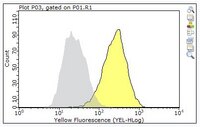Processing of C3b-opsonized immune complexes bound to non-complement receptor 1 (CR1) sites on red cells: phagocytosis, transfer, and associations with CR1.
Craig, ML; Waitumbi, JN; Taylor, RP
J Immunol
174
3059-66
2004
Kivonat megmutatása
Severe anemia is a lethal complication of Plasmodium falciparum malaria, particularly in children. Recent studies in children with severe P. falciparum anemia have demonstrated elevated levels of E-bound Abs, reduced E-associated complement receptor 1 (CR1) and decay-accelerating factor (DAF), and pronounced splenic enlargement, suggesting a mechanism for E loss involving Abs, complement, and phagocytosis. Motivated by these reports, we have developed an in vitro model in which human E with Abs and complement bound to CR1, DAF, or glycophorin A are incubated with model human macrophages (the THP-1 cell line). Previous work has demonstrated that immune complex (IC) substrates bound to E CR1, either by an Ab or via C3b, are transferred to macrophages with loss of CR1. In this study, we report that IC bound to DAF or glycophorin A by an Ab linkage are also transferred to macrophages. DAF is lost from the E during the transfer of DAF-bound IC, but the transfer of CR1-bound IC does not lead to a significant loss of DAF. Using glycophorin A-bound IC, we observe competition between transfer of IC and phagocytosis of the E: a fraction (</=15%) of the E was phagocytosed, while the remaining E were stripped of IC. We also examined the organization of CR1 and DAF in the presence of E-bound Ab/complement. We find that CR1, but not DAF, colocalizes with IgM mAb-C3b and IC-C3b substrates attached to glycophorin A. We observe that the binding of the IgM mAb-C3b to glycophorin A induces a novel unclustering of CR1. | 15728520
 |
Mapping epitopes for 20 monoclonal antibodies to CR1.
Nickells, M; Hauhart, R; Krych, M; Subramanian, VB; Geoghegan-Barek, K; Marsh, HC; Atkinson, JP
Clin Exp Immunol
115
27-36
2001
Kivonat megmutatása
Complement receptor type one (CR1; CD35) binds and processes C3b and C4b opsonized immune complexes and regulates complement activation. We have characterized the epitopes of 13 previously reported and seven new MoAbs to human CR1. The MoAbs formed seven groups based on their reactivity with a panel of deletion forms of CR1. Seventeen of the MoAbs reacted with CR1 at more than one site, a consequence of its repetitive sequence. All five of the MoAbs recognizing epitopes in the nearly identical repeats 3, 10, and 17, as well as one MoAb which reacted with repeats 8 or 1/2 of 9 and 15 or 1/2 of 16, blocked cofactor activity for C3b. Knowledge of the repeats bearing the epitopes for these MoAbs should facilitate the further characterization of CR1. | 9566786
 |









